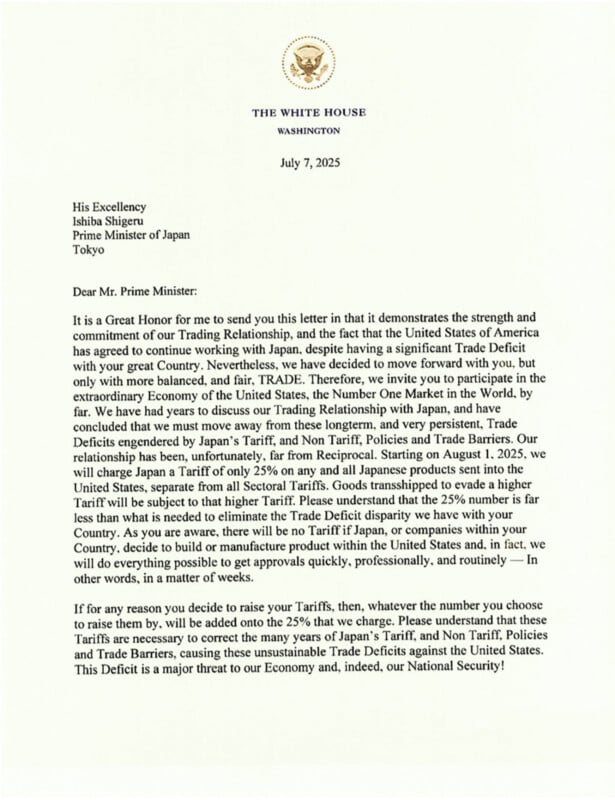Trump Sends Letter to Japan Outlining 25% Tariff Starting on August 1

In yet another tariff development, President Donald Trump said today that he is sending letters to Japan and South Korea outlining a plan to raise tariffs on imports from both countries to 25% on August 1. The news comes one day after U.S. Treasury Secretary Scott Bessent went on CNN to discuss Trump’s latest tariff plans.
President Trump posted a series of letters addressed to various world leaders on Truth Social, each outlining his administration’s tariff plans and offering a thinly-veiled threat to increase tariffs if any of the recipient countries chooses to respond in kind with tariffs on American exports.
In his letters to Lee Jae-myung, President of the Republic of Korea, and Shigeru Ishiba, Prime Minister of Japan, Trump promised a 25% tariff rate against both countries’ goods.
“It is a Great Honor for me to send you this letter in that it demonstrates the strength and commitment of our Trading Relationship, and the fact that the United States of America has agreed to continue working with Japan, despite having a significant Trade Deficit with your great Country,” Trump writes to Prime Minister Ishiba. “Nevertheless, we have decided to move forward with you, but only with more balanced, and fair, TRADE. Therefore, we invite you to participate in the extraordinary Economy of the United States, the Number One Market in the World, by far.”

![]()
The letters to other world leaders, including those in Myanmar, Laos, South Africa, Kazakhstan, and Malaysia, echo similar sentiments, albeit with minor differences. In each, including those addressed to Japanese and South Korean leaders, Trump describes trading relationships as “far from Reciprocal.” The letters also characterize the tariff rates as “only 25%,” or higher in the case of Myanmar, Laos, and South Africa.
“Please understand that the 25% number is far less than what is needed to eliminate the Trade Deficit disparity we have with your Country,” Trump writes to Prime Minister Ishiba.
Each letter also reiterates that tariffs will not apply to companies that build or manufacture products within the United States, and outlines that any reciprocal tariff a country enacts will be met in kind, with that percentage added onto the Trump administration’s selected tariff rate.
“This Deficit is a major threat to our Economy, and indeed, our National Security!” Trump adds, before offering recipients the opportunity to have their tariff rates adjusted if they provide the United States with a beneficial trade agreement.
“You will never be disappointed with The United States of America,” Trump concludes.
The original tariff rates announced on April 2 were 24% for Japan and 25% for South Korea; thus, little has changed in the interim period during which Trump temporarily reduced tariffs against each country and many others to 10% following economic concerns. Following today’s barrage of tariff news, the Dow Jones Industrial Average dropped by over 420 points, while the S&P 500 and NASDAQ fell by nearly the same percentage amount.
White House spokesperson Karoline Leavitt stated during her daily briefing that more countries will receive letters in the coming days, although she did not identify them. She also said that Trump would sign an executive order today to officially postpone the initial July 9 deadline until August 1.
These negotiations are playing out against the backdrop of a significant legal battle over the legality of Trump’s tariffs. Given that situation, which is awaiting appeal, it is notable that the President framed trade deficits as a “major threat” to national security, given that his alleged legal standing to implement tariffs like he has relies upon the 1977 International Emergency Economic Powers Act (IEEPA), which gives the sitting President legal authroty to regulate international trade in response to a declared national emergency.
The U.S. Court of International Trade ruled in May that persistent trade deficits with trading partners do not reflect a threat to America’s national security. A federal appeals court promptly intervened and issued an administrative stay pending appeal. The appeal is expected to start by the end of this month, just one day before the new August 1 tariff deadline.
If no deal is reached with Japan and the U.S. ultimately institutes a 25% tariff on Japanese imports, photographers should prepare to pay the price, as Japanese companies and retailers will not want to absorb the additional cost themselves. The tariffs will be passed directly to the consumer. The price hikes that have already occurred, reflecting the 10% tariff currently in effect, will undoubtedly increase to, or at least very near, the 25% value once the new tariff is levied against imported goods.
Image credits: Header photo licensed via Depositphotos.
Source link



